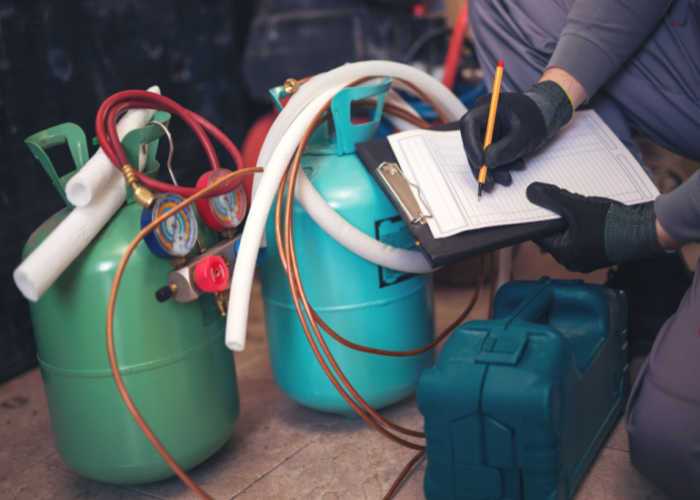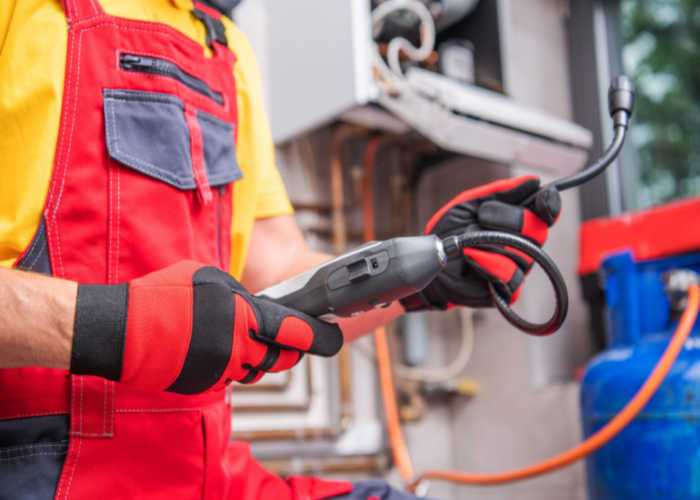Stationary temperature control solutions containing fluorinated gases (F-gases) - like heat pumps, air conditioners and process cooling systems - became subject to EU Regulation 517/2014 in 2015. What this regulation enforced on operators of such systems was a responsibility to ensure refrigerant containment through regular leak testing.
Whilst the UK has since separated from the EU, it enforces the same rules through the Ozone-Depleting Substances and Fluorinated Greenhouse Gases (EU Exit) Regulations 2019. This means that F-gas leak testing remains a legal obligation you can’t afford to ignore.

F-gases are a family of man made gases - hydrofluorocarbons (HFCs), perfluorocarbons (PFCs) and sulphur hexafluoride (SF6) - used in a wide range of industrial applications. HFCs are the most common in temperature control systems, and play a crucial role - constantly shifting from gas to liquid state for heat transfer.
You’ll find these HFCs have a range of trade names, but are typically referred to by their R number. Those you may have heard of include:
R32: the newest F-gas available, ideal for use in smaller air conditioning units
R410A: commonly used as a replacement for the banned R22, well suited to larger AC and VRF systems
R404A: widely used in low and medium temperature refrigeration applications
Unlike ozone-depleting CFCs, F-gases do not damage the atmospheric ozone layer. They are, however, still greenhouse gases with global warming potential (GWP) much higher than that of carbon dioxide.
A GWP rating indicates how damaging a gas is to the environment relative to CO2, with CO2 itself given a GWP of 1. For context, the GWP ratings of our common HFCs are:
R32 - 677
R410A - 2,088
R404A - 3,922
Those figures may sound alarming, but when handled correctly F-gases are generally safe - hence the legal requirement for careful control. Part of this is limiting any adverse effects by ensuring they do not leak out of your temperature control system and into the atmosphere.
There are two methods of carrying out F-gas leak testing - the manual (or direct) method, and the automatic (or fixed) method.

The manual method may make use of a hand held leak detector, a bubble solution, or tracer dyes and UV lamps. As you’d expect, the automatic method uses permanently fixed systems where sensors are placed to detect a leak. These systems then alert the operator, or their maintenance company, that a leak is taking place. If you have a fixed system installed you still need to run manual checks, just not as often.
In cases where a leak is found, it must be repaired as soon as feasibly possible, and the system retested within a month. You and your maintenance company must also keep records of leak tests and repairs (along with other details required under F-gas obligations) for at least five years.
How often a system needs to be tested depends on the type and amount of F-gas used. By law, this information must be visible on product labels - where you’ll typically see the mass of F-gas expressed in kg.
To complicate matters, this needs to be converted into a tonnes of CO2 equivalent, the result of which will tell you the required F-gas leak test frequency. To do this, you must divide the mass of F-gas by 1,000 to convert it to tonnes, then multiply this by the gas’ GWP (you can find more information and example calculations here).
Using R32 as an example, if your system contained:
7.4kg - this is equivalent to 5 to <50 tonnes of CO2. Your system would need to be leak tested every year (once every two years if a fixed leak detector is installed)
74.1kg - this is equivalent to 50 to <500 tonnes of CO2. Your system would need to be leak tested every six months (once every year if a fixed leak detector is installed)
If your system contained >500 tonnes of CO2 equivalent, you must have a fixed leak detection system in place. You must also undertake manual testing every six months.
F-gas leak tests can only be carried out by qualified engineers. These engineers must have a category 1 certificate in working on equipment containing F-gas from the likes of BESA, LCL Awards or City and Guilds.
They must also work for a company that is certified to install, repair, maintain and decommission stationary equipment containing F-gas. This certification can be obtained from Bureau Veritas UK, F-Gas Register or REFCOM. If work is undertaken by anyone not qualified to do so, your temperature control system will not be legal and you may receive a hefty fine.
At Loughborough Air Conditioning, we pride ourselves on going beyond basic requirements. In addition to our F-gas certificate from REFCOM we’re also members of REFCOM Elite - a voluntary scheme that promotes best practice in refrigerant management - and all our engineers are registered under the ACRIB F-Gas Refrigeration SKILLCard scheme.
We’ve been helping businesses across the East Midlands stay F-gas compliant for over 20 years and offer regular F-gas leak testing as part of our planned preventative maintenance packages.
